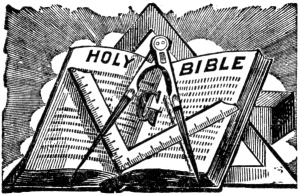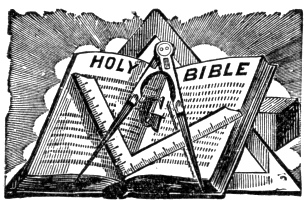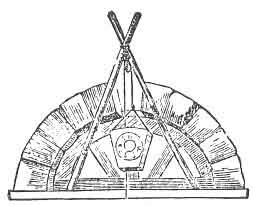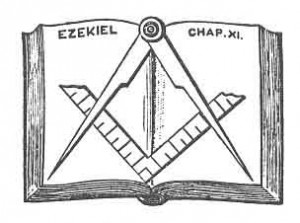None but he who has visited the Holy of Holies, and travelled the road of peril, can have any conception of the mysteries unfolded in this degree. . The MASTER MASON represents a man under the doctrine of love, saved from the grave of iniquity, and raised to the faith of salvation. p. 127 It testifies our faith in the resurrection of the body, and while it inculcates a practical lesson of prudence and unshrinking fidelity, it inspires the most cheering hone of that final reward which belongs alone to “just made perfect.”–Lexicon.
129:1 THEOREM.–In any right-angled triangle, the square which is described p. 130 upon the side subtending the right angle, is equal to the squares described upon the sides which contain the right angle.–Euclid, Lib. i. Prop. 47.
137:1 We are told that when the Temple was nearly finished, it was customary at the hour of H. (high) XII., when the men were called from labor to refreshment, for H. A. B. (Hiram Abiff) to retire to the Most Holy Place, to draw his plans and designs, and offer up his orisons, &c. But flow could this be accomplished before the Sanctum Sanctorum was built. And, if finished, he would not have been permitted to enter it; for one living person alone possessed that privilege, viz., the High Priest, and he only once a year. Besides, when a work is nearly completed, the necessity of Plans and designs ceases altogether. But we are assured, that not only were the plans drawn and the specifications approved, but every other preparation was made for completing the work before the foundations were laid; even the stone and timber were carved, marked, and numbered before they were removed from the quarry and the forest; and, hence nothing was required, when the materials were conveyed to Jerusalem, but skilled labor to make it perfect and complete from foundation to cope-stone.
Again, some of the rituals taught that H. A. B. divided the operatives the three classes, viz., Apprentices, Fellow Crafts, and Masters; paying the wages of the former at the pillar of J (Jachin), and the Masters in the Middle Chamber. Now, as in p. 138 the former case, this arrangement would be impossible before the pillars were erected or the Middle Chamber built: and if it he pretended that any such plan was adopted after they were finished, the tragic drama could not be true because it professes to have been enacted before the Temple was completed.
And finally, the veracity of the legend is completely ignored by a reference to the Holy Scriptures. which constitute our authority for affirming that no such event ever happened; for H. A. B. not only lived to finish all the work, in whatever capacity he might have been engaged, but also, according to the testimony of Josephus, who calls him ABDEMON, he returned to Tyre, and died there at a good old age.–The Freemason’s Treasury, pp. 299-300.
138:1 Our traditions further say, that the time when this celebrated use went into the H. of H. (Holy of Holies) to offer up his orisons to God, at the hour of H (high) twelve, the Ark of the Covenant had not been removed thither, for that took place at the dedication, after which no one was permitted to enter but the H. P. (High Priest), and he only ours a year, on the great day of expiation, at which time he had a string or belt around his waist, which extended into the court of the tabernacle, that he might be drawn forth from the S. S. (Sanctum Santorum) in case sudden death should occur while he officiated there.–Historical Land-marks, vol. it. p. 154.
138:2 A similar divergence from uniformity will be found in describing the p. 139 places where the above-mentioned instruments were supposed to have been used with such terrible effect. In the primitive lectures–i.e., those which were used after the Revival in 1717, for the subject was never ventilated before that date–they were called “the three principal entrances to the Temple”; but subsequently it was thought expedient to particularize these entrances; and the passage was altered at first to “the east, west and south doors”; and, at the Union in 1813, the version became “north, south, and east entrances.” In the United States they say that the first attack was made at the south door, the second at the west door, and finally at the east. In Scotland the arrangement is east, south, and west. In France, it was originally south, north, and east, but now west, south, and east. In the Adonhiramite Masonry, which was used there about 1787, the doors are not mentioned at all.–The Freemason’s Treasury, p. 307.

Moe is the founder of GnosticWarrior.com. He is a father, husband, author, martial arts black belt, and an expert in Gnosticism, the occult, and esotericism.






